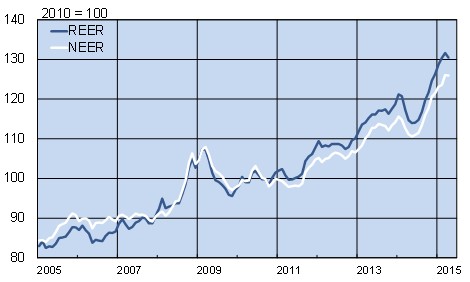BOFIT Weekly Review 22/2015
IMF no longer considers the yuan undervalued
Concluding its annual Article IV country review, the IMF consultation mission this week released a brief appraisal of the Chinese economy and its policy recommendations. The IMF expects China’s economic growth to slow this year to 6.8 % and inflation to remain around 1.5 % at year’s end. It said China’s labour market has performed well under slowing growth, which has supported household consumption.
Since the global financial crisis, China’s growth has been largely based on fixed asset investment financed with debt. The problems related to debt and overcapacity will require an on-going response in the years ahead. If the GDP growth exceeds the official 7 % target due to further declines in oil prices and stimulus actions already taken, China should reduce its debt and overcapacity problems faster. If GDP growth falls below 6.5 %, however, further stimulus should come transparently from fiscal easing. Furthermore, any stimulus should be geared to protecting those in weakest position and supporting balanced economic growth and reforms.
To increase productivity, IMF recommends transition to a market-based financial system. In practice, it is time to liberalise deposit interest rates and transit to monetary policy based on interest-rates. This requires the introduction of genuine policy interest rates in implementing monetary policy. The implicit guarantees that affect the entire financial system must be gradually lifted.
The IMF estimates that the yuan’s real effective exchange rate has strengthened to the point where the yuan should no longer be considered undervalued. However, the large current account surplus requires further reforms to reduce excessive saving. The IMF strongly recommends allowing more adjustment of the yuan and moving to a floating exchange rate within 2–3 years. The IMF said it will be only a matter of time when the yuan will be added to its Special Drawing Rights (SDR) basket currency.
Nominal and real effective yuan exchange rates

Source: BIS